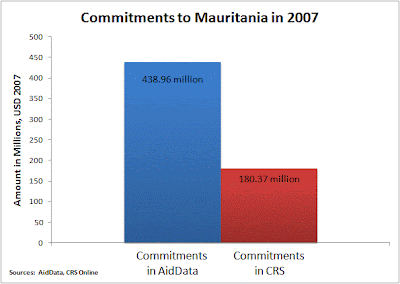AidData for aid workers
Today I'm pleased to have a guest post from Dan Nielson and Jonathan Chan of AidData. As you probably know by now, AidData is a fantastic new portal offering access to data on development finance. Since I know many readers of this blog are not academics or economists whose hearts go aflutter at the mention of readily available free data on a wide variety of subjects, I asked Nielson and Chan to focus on the ways that practitioners in the aid and development community can use the service. What follows should be of great use to those of you who are involved in the field:
=====
As long-time readers of the Texas in Africa blog, we were delighted at the invitation to write a guest post about AidData. For those who don’t know, AidData is a new online portal that provides access to the latest data and research on development finance. The data cover approximately $4.2 trillion USD: nearly doubling the amount of development finance tracked by a single source. Along with the International Aid Transparency Initiative, aidinfo, Publish What You Fund, AidWatch, and the OECD’s Development Assistance Committee (among others), AidData attempts to make aid as transparent as possible.
The heart of the project is our collection of nearly one million aid activity records that span the last 65 years of development assistance. Although much of the information comes from traditional donors via existing databases, AidData adds its greatest value by improving what is known about loans from the big multilateral donors like the World Bank, the regional development banks, and the International Monetary Fund. AidData also includes often-overlooked heavy hitters like Saudi Arabia and Kuwait.
So data data data. While that turns nerds like us on, how about a more practical example of how AidData would help someone outside of academia.
Let’s say you’re a project manager tasked to integrate local efforts with national and international development projects in Mauritania. One of the first questions you might want to answer: what has already been done, and by whom? Since AidData includes activities from non-traditional donors, you would now have access to information for more than $226.7 million in development assistance that would have been all but invisible a few months ago.

Using the AidData Purpose and Activity classifications, you could also examine the sectoral and sub-sectoral allocation of aid in Mauritania, finding that over $140 million was committed to the water supply and sanitation sector. Going beyond aggregate figures to looking at individual projects, you would learn that most of this money was allocated towards a massive project begun in 2003 to pump potable water from the Senegal River to Nouakchott, the capital.
The information for four of the donors involved in this project—Saudi Arabia, Kuwait, AFESD, and OPEC—have until now not been accessible via any centralized data tracker. In the project detail view, the long descriptions provide information on the location of pumping stations, treatment plants, and reservoirs. A project manager can use this to focus new activities on the areas that will benefit as the supply of potable water expands along the pipeline. The manager can also avoid duplicating water and sanitation efforts. Finally, the keyword search can help identify other projects implemented in and around Nouakchott, including these very specific interventions in health and emergency services funded by Monaco.
AidData is still beta, and we’re continually tinkering with it to make both the website and the underlying information more useful. For example, a small number of countries and agencies provide the name and information of a staff member directly involved in the project, and we’d like to begin publishing that information so that project managers can coordinate directly with one another. Some donors also publish project documents, including planning papers, progress reports, and independent evaluations. Publishing these will allow project planners and implementers to learn directly from previous experiences. We’re also planning to develop country and sectoral dashboards that will generate on the fly graphs and visualizations to quickly understand and communicate a country’s or sector’s aid makeup.
To check out the beta version of our site, go to www.aiddata.org. We love feedback of any kind, so you can also write to us at info@aiddata.org about both what we’re doing right and what we’re doing wrong. In the end, it’s all about transparency.
Dan Nielson is a principal investigator at AidData, as well as the Director of the Political Economy & Development Lab at Brigham Young University. Jonathan Chan is the Project Manager for Emerging Donors at AidData, and a research associate at The College of William & Mary.
Thanks so much for this interesting and informative post. Have you tried using AidData in your work? Where could you see it being useful?
1 Comments:
You guys have totally turbo-charged my journalism. And just in time for a four-country reporting project on, well, aid...
Monday, May 10, 2010 11:55:00 AM
Post a Comment
<< Home